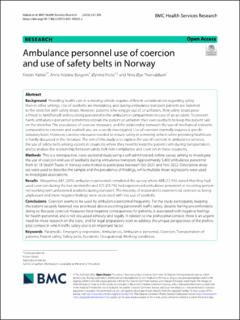| dc.description.abstract | Background Providing health care in a moving vehicle requires different considerations regarding safety
than in other settings. Use of seatbelts are mandatory, and during ambulance transport patients are fastened
to the stretcher with safety straps. However, patients who wriggle out of, or unfasten, their safety straps pose
a threat to him/herself and escorting personnel in the ambulance compartment in case of an accident. To prevent
harm, ambulance personnel sometimes restrain the patient or unfasten their own seatbelts to keep the patient safe
on the stretcher. The prevalence of coercive measures, and the relationship between the use of mechanical restraints
comparable to coercion and seatbelt use, are scarcely investigated. Use of coercion normally requires a specific
statutory basis. However, coercive measures needed to ensure safety in a moving vehicle while providing healthcare
is hardly discussed in the literature. The aim of this study is to explore the use of coercion in ambulance services,
the use of safety belts among escorts in situations where they need to keep the patient calm during transportation,
and to analyse the relationship between safety belt non-compliance and coercion in these situations.
Methods This is a retrospective, cross-sectional study using a self-administered, online survey aiming to investigate
the use of coercion and use of seatbelts during ambulance transport. Approximately 3,400 ambulance personnel
from all 18 Health Trusts in Norway were invited to participate between Oct 2021 and Nov 2022. Descriptive analy-
ses were used to describe the sample and the prevalence of findings, while multiple linear regressions were used
to investigate associations.
Results Altogether, 681 (20%) ambulance personnel completed the survey where 488 (72.4%) stated that they had
used coercion during the last six months and 375 (55.7%) had experienced ambulance personnel or escorting person-
nel working with unfastened seatbelts during transport. The majority of respondents experienced coercion as being
unpleasant and more negative feelings were associated with less use of seatbelts.
Conclusions Coercion seems to be used by ambulance personnel frequently. For the study participants, keeping
the patient securely fastened was prioritized above escorting personnel’s traffic safety, despite feeling uncomfortable
doing so. Because coercive measures have negative consequences for patients, is associated with negative feelings
for health personnel, and is not discussed ethically and legally in relation to the prehospital context, there is an urgent
need for more research on the topic, and for legal preparatory work to address the unique perspectives of the prehos-
pital context in which traffic safety also is an important factor. | en_US |

